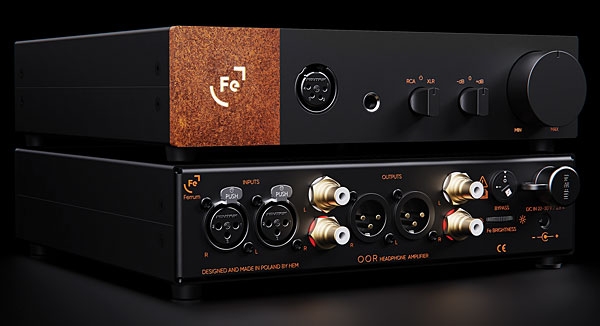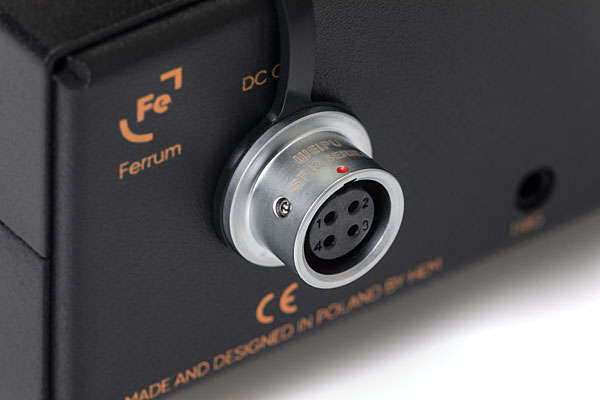| Columns Retired Columns & Blogs |
Lovely to listen to and lovely to behold...
And, priced for the somewhat common man!

Audio-frequency power amplifiers take a small input signal—usually less than 1V—apply it to an input impedance of (typically) no less than 10k ohms, and make this tiny eye-blink of power (0.0001W) into a waveform that's many times more powerful, capable in some cases of doing hundreds of watts of speaker-moving work. To grasp the magnitude of this chore, and what I am about to describe, it might be useful to imagine power amplifiers as energy adders.
The majority of audio amplifiers I've encountered were built in closed metal boxes (with power cords), and every high school grad knows that energy is conserved: neither gained or lost. Therefore, if we want more energy at the output—if we want the amplifier to amplify—then we need to import energy from an outside source (like our household AC line) and store it in something—capacitors—that's engineered to hold and release a rapidly varying stream of energy.
Audio frequency amplifiers are notoriously inefficient. Therefore, amplifiers of the highest fidelity must not only store (by necessity limited) volumes of stable "standing" energy in their capacitors; they must also have effortless access to a flow of fresh energy through their power cords (to fill and refill those capacitors) and, equally important, a direct, low-impedance path to an infinite source of free electrons from our good and gracious Mother Earth.
Importing and outflowing energy with some amount of reliable precision is a messy, variable-plagued business, which is why an audio frequency power amplifier can only be as effective, linear, and exciting to use as its power supply allows it to be.

The Ferrum HYPSOS Hybrid Power System
When I saw my first two-page magazine ad (in our sister magazine Hi-Fi News) for the Ferrum HYPSOS "Hybrid Power System," I smiled and felt validated. The ad looked enticing, and its points were well-stated. I wondered where this Ferrum company (footnote 1) came from and how the Ferrum people had the courage to make and market what appeared to be a fully formed hip'n'cool–looking variable-voltage audio power supply. They must have known I hated wall warts and that I think switching supplies are bean-counter ruses to save money on transformer iron.
Ferrum's logo is Fe, which is the symbol for the element iron and the abbreviation for the Latin word "ferrum"; which is Latin for iron, which, in its usual metallic form, is a rather dense, crystalline substance capable of being magnetized.
The Ferrum HYPSOS Hybrid Power System and Ferrum's matching OOR headphone amp (auditioned below) are both made in Poland by the same company (HEM) that distributes Clarus Cables in Poland and until recently manufactured Mytek products.
On their website, Ferrum Audio says that the HYPSOS is their first product, calling it a "linear/switching hybrid power system" that accepts 110–240V AC in and can output a user-selectable DC voltage from 5V to 30V at up to 6A. It's priced at $1195.
On their website, Ferrum claims that their hybrid design offers "the best of switching and linear supplies." Via email, Roy Feldstein of VANA (Ferrum's US distributor) explained Ferrum's choice to make the HYPSOS a hybrid design: "Linear regulators have low ripple and noise as well as fast transient response. Switching power supplies have higher efficiency. Ferrum wanted it all."
The engineering team at HEM/Ferrum told me in an email that the design of the HYPSOS supply begins with a noise-reducing input filter to clean incoming AC. That's followed by a stepdown transformer, which feeds Schottky diodes and four 4700µF electrolytic capacitors (for smoothing and storage). That's all pretty standard. After that is where it gets interesting.

According to the HEM engineers, "That first linear supply feeds a low-ripple switching supply (SMPS) through a single-stage filter, and there is a two-stage filter on the output of the switching supply. The design and implementation of these input and output filters are critical to the performance of the HYPSOS. To further reduce noise, the SMPS has a spread-spectrum mode. This mode modulates the switching frequency by 20%. This technique reduces EMI because the spectrum of noise generated by multiple switching frequencies and their harmonics is lower in magnitude than those of a single switching frequency.
"Following the SMPS is a low-noise linear regulator. This final regulator is a low-dropout design based on an NMOS [negative channel metal oxide semiconductor] transistor. In the context of linear power supplies, the term 'low-dropout' means that the device can regulate the output voltage even if the input voltage is only slightly higher than the output voltage. In the HYPSOS, the output of the switching supply is less than 1 volt greater than the output voltage of the linear power supply. This attribute increases the efficiency and reduces the heat output of the supply. An ARM-based microprocessor adjusts the duty cycle of the SMPS and the reference voltage of the linear regulator to vary the output voltage. This processor also controls all the other functions of the unit."


The main job of a power amplifier's power supply is to effortlessly deliver constantly varying ratios of voltage and current to a constantly fluctuating load. To that end, the HYPSOS specifies maximum continuous output current (for voltages below 13.3V) at 6A. For output voltages greater than 13.3V, Ferrum specifies that the DC output current will adjust to equal 80W maximum power. The HYPSOS weighs 6lb and measures 8.6" wide × 8.1" deep × 2" high. The warranty is for three years.
Obviously, to audition Ferrum's HYPSOS power supply, I will need to connect it to a component that requires power and that can utilize a remote power supply. On their website, under the heading "Works with!" Ferrum provides a continuously updated "Compatibility list" of the brands and component models the HYPSOS will service. Currently, this list includes dozens of well-known brands: Arcam, Audioengine, Auralic, Bel Canto, Cambridge Audio, Chord, Creek, Denon, exaSound, Gold Note, Mytek, Stax, Sonore, Roon, iFi Audio, Musical Fidelity, Naim Audio, McIntosh, and others.
But first, the OOR
I thought it would be wise to start my HYPSOS auditions by not using it; instead, I spent time listening to Ferrum's second product—the OOR preamp/headphone amplifier ($1995)—with its standard off-chassis ("wire-wart") power supply.
The headline on the Ferrum webpage for the OOR says "OOR, the only headphone amplifier with a soul." The sales pitch continues farther down in smaller print, "OOR will drive any headphones effortlessly to the max of their potential, while preserving the essence of the music it amplifies." Normally, I am turned off by such website hyperbole, but in the case of these new Ferrum products, I found myself being drawn in. Ferrum's ad writers wrote all the right words. Headphone dedicants like me study recordings like a monk studies ancient texts, seeking the soul and essence of the music being amplified. The opportunity to audition a top-tier headphone amp with both a standard and optional supply was my chief inspiration for creating this report.
When the HYPSOS and OOR arrived, besides listening with them, I had a strong desire to know all about the thinking that motivated their design. I asked about the nature of the OOR's circuity and how the OOR is different than other headphone amplifiers at this price level. HEM Hardware Engineer Maksymilian Matuszak responded. This is an abbreviated version of his email response:

"The input stage of the OOR adjusts gain and volume and is made from fast op-amps with external compensation. After that, there is a unique, discrete-transistor output stage based on low noise BJT [bipolar junction] transistors. It is not class-A; it is rather something between class-A and -AB. It does not use a full-time operational current source, which forces the current through one transistor. Instead, it employs special circuitry, which never turns off either of its two output-steering transistors, which are polarized similarly to class-AB.
"The current through both output transistors is monitored by independent circuits that prevent it from dropping below a predetermined threshold value. The OOR's output stage is linearized by the feedback loop of its discrete current-feedback amplifier, which has about 60kHz of open-loop bandwidth (–3dB) and almost 1MHz of closed-loop bandwidth (–3dB). This wide open-loop bandwidth is not present in [integrated-circuit–based] headphone amplifiers.
"The OOR's entire signal path is DC coupled and fully balanced. All gain circuitry is fully balanced (even on the RCA input) because the input amplifier is converting the single-ended signal to balanced. Volume regulation is handled by a custom, 4-channel Alps attenuator. To accommodate single-ended output, the signal is converted to single-ended at the RCA outputs."

Lovely to listen to and lovely to behold...
And, priced for the somewhat common man!

Hi
Sorry, being a vinyl addict, I am extremely skeptical about whatever digitals involved in analogue amps. My ears can tell it's "lovely to listen to" or not.
As an analogue audio DIYer, I will never put any digital electronics inside my amps, period. NOooo switching power supplies please.
Yes, SMPS is very efficient & CHEAP to get constant voltage output even with large current fluctuating. But it affects the music, IMO.
Yes, I used SMPS wall warts as well !! But only to recharge the MNH batteries which provide the bias voltages for ALL the triodes inside my design/built preamp & power amps. But once the amps are operating, the wall warts are 100% electrically disconnected from the amps.
SO no RFI/EMI from the SMPS can get into my triode amps to impair the music.
Listening is believing
Jack L

I should have said, "Lovely for some people to listen to, maybe many people, but not Jack L."
I apologize for generalizing about whether or not something like this can sound lovely. For a moment, I failed to consider I was on the internet!
I probably over generalized about the visual appeal, as well.
I will change my original opinion to, "Perhaps lovely for some, but not all, to listen to; and perhaps lovely for some, but not all, to behold; and possibly not lovely in either way for everyone. Perhaps not priced low enough for some nor high enough for others."
I do realize that different belief systems affect the sound. I was too relaxed in my approach and my comment lacked the discipline required to measure up on the interwebs.

Hi Anton.
Take it easy. You voiced your opinion which may or may not in line with everybody in the world. But so what ???
No big deal ! It is imperial that you speak out with your heart. That is what really matters. Right ?
Jack L


Still dying of laughter...
Greatest Stereophile poster of All Time = Anton.

Hi
"Whoosh" by the seat of my pants !!!!
Jack L

HR wrote: ”Maybe more audiophiles will realize that audio amplification is about adding clean, natural energy to signals—and most importantly, that properly energized amplification makes recorded music sound denser, more vibrant, and more plausible.”
I can't agree more. Music reproduction starts by supplying (adding) clean power because the AC from our wall outlets is not clean. Many companies offer their solutions for clean power as Power Conditioners, which IMO not solves the problem and have always left me frustrated. Therefore, in 2008 I bought a PS Audio Power Plant P1000 and will not live without it. The equipment is connected through 8 Power Cables from Synergistic Research Reference Series at that time and of course the power plant has it's own! Not a cheap solution, given I am living in EU, but the only thing that makes sense to me and never leave me frustrated. Lots of micro/macro-dynamics, lots of detail, depth and ambience. Precise instrumental location. I don't have to wait to late hours in order to get clean AC. I just push the standby button and get it. The investment has been worth every dollar!
Always interesting and inspiring to read Your reviews and GD's HR!